|
 |
Camelot at Flushing Meadows:
The Kennedys and the Fair
by David Oats, November 22, 2003
"We hope that you will bring us luck - the luck
of the Kennedys
and the United States of America."
- Mayor Robert F. Wagner to President John F. Kennedy at the
Groundbreaking for the United States Pavilion for the 1964-1965
New York World's Fair, Flushing Meadows, December 14, 1962
|
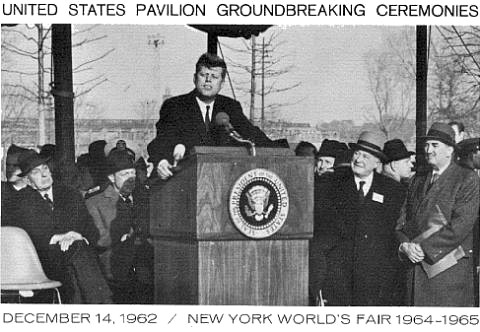
NOVEMBER 22, 1963
I didn't know where to go.
It was as if the floor had disappeared and ...
what? Everyone felt it that day. I was in a classroom at St.
Michael's School in Flushing, Queens when a nun suddenly came
into a 7th grade English class and told the students to double-up
in another classroom down the hall. It had a TV. We all had done
this before for air-raid drills during the Berlin Wall and Cuban
Missile Crises, or to watch the launch of John Glenn and his
three-hour orbit of the earth. It was always scary or exciting
or a combination of both. But the faces on the teachers were
different this time. Before turning on the TV the nun told the
crowded classroom that she had some bad news. The President had
been shot. And they thought we should now all just watch the
TV.
Everyone who was alive that day - Friday, November
22,1963 - remembers where they were when they heard the news.
It was for our generation just like we used to hear our parents
talk about how they remember exactly where they were and what
they were doing on December 7, 1941, when the attack on Pearl
Harbor was announced. I suppose it is like what all of us alive
on September 11, 2001 will always feel.
After agonizing minutes of waiting the students
watched, like the rest of the nation, Walter Cronkite announce
officially that President John Fitzgerald Kennedy had
died. Wiping away his own tears, the newsman said that Lyndon
Johnson would soon take the Oath of Office as the next President
of the United States. Many in the class erupted in gasps and
tears. The nun shut down the TV and told us to pray. They huddled
with the other teachers and the principal and then announced
that we should all go home to be with our parents and family.
I remember walking the always bustling streets
of downtown Flushing on my way home and watching people walking
in a daze, like zombies, talking to strangers or standing in
front of local appliance shops just watching black and white
TV sets in the store windows. It was eerie. I got home to my
housing project on Roosevelt Avenue in Flushing, but I was alone
- both parents still at work in Manhattan. I couldn't call them
because they were on their way back home also.
I didn't know where to go. But then I did! I ran
out of my apartment like a maniac. I ran across the Roosevelt
Avenue bridge under the IRT No. 7 subway trestle and ran and
ran until I reached the gate that led into Flushing Meadow Park.
There was the Administration Building for the upcoming 1964-1965
New York World's Fair, a one-story, unimposing prefab looking
structure that stood outside the main construction site where
the great international exposition was rising in the background.
I knew why I had to come here. It was the only place where I
could truly think about this moment that had had just seemed
to change everything. All I could think about was another day,
just barely a year before . . .
|
|
DECEMBER 14, 1962
When I had first seen that building in the late
summer of 1962 it was a scary place where the Pinkerton Guards
had unceremoniously dropped me off after stopping me from my
sneaky excursions into the construction site of the Fair. Then,
one day, the guard's "boss" spotted me and told his
secretary to take my name and address down so they could send
me stuff on the future Fair and I wouldn't get caught in that
dangerous place until the Fair was ready in 1964. Shortly after
that I started getting all kinds of neat stuff from the Fair:
Progress Reports, Fair News newsletters, glossy
photos of future Fair buildings, etc. It didn't take long to
learn, pursuing these intriguing booklets, that the guard's "boss"
was actually the FAIR'S BOSS - this guy Robert Moses, who my
father proudly told me was "a great man -- he built Jones
Beach!" Then one day in late November, I got another mailing
from the Fair - but this one looked different. It was a typed
letter saying that I was cordially invited to the Official Groundbreaking
Ceremony for the United States Pavilion on Friday, December 14,
1962.
It sounded cool but that was a school day! I showed
the letter to my teacher and she said it should be "very
educational" and I could take off, but I had to write a
little report on the event for the class. "Great!"
But then I got a little scared. The building was still intimidating
to me and when I called to RSVP, I asked if my parents could
come. "No," I was told. "The invitation is only
for one." My parents said I should wear a tie and jacket.
For a 12 year old, former Pinkerton cop fugitive, this was frightening.
I showed up at that dreaded Administration Building, invitation
in hand and a tall Pinkerton guard was there to check it. He
looked at me real hard, asked where my parents were and asked
if I had any ID! I didn't. He went to the side and made a call
on his walkie-talkie (I noticed he had a gun also). He then folded
the letter, waved me on into that scary building and ... smiled.
Inside the Administration Building, everything
was abuzz. Photographers, ADULTS, guards, ADULTS, pretty secretaries,
cops, ADULTS. Then a nice lady came up and asked if I was lost.
I just knew this was some kind of mistake, this invitation, but
she put me at ease and asked me if I was excited to see the President.
I thought she meant Robert Moses and I said "Yes."
She laughed and said, "No. The PRESIDENT OF THE UNITED STATES,
PRESIDENT KENNEDY." It didn't say anything about that
on the invitation! She said, "He's on the way from La Guardia
right now and he'll be here in a few minutes." Just then
another flurry of activity took place and, in the lobby, I could
see the old man, the guard's "boss," right next to
me in the very crowded lobby. Someone went to push me away but
then the old man stopped and said, "Oh, here's my friend
from the neighborhood. Glad you could come. Show him the model."
Then I was whisked away into this large room where there was
the most amazing toy I had ever seen. A huge scale model of the
entire future New York World's Fair ... with lights! Forget the
President! This was cool beyond belief!
President Kennedy surveys the model of the Fair
with Norman K. Winston, US Commissioner for the Federal Pavilion
and Mayor Robert F. Wagner, both to his immediate right.
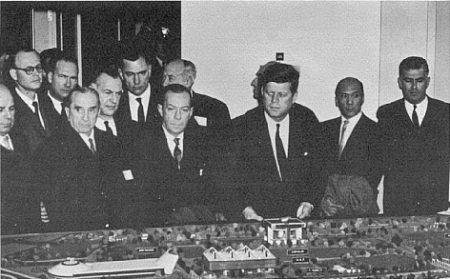 |
But my fascination with the model was soon interrupted by a huge
herd of photographers and reporters scrambling into the model
room, pushing me to the side with lots of "outta the way
kid" shouts. Before I knew it there was Mayor Wagner - such
a familiar face on nightly local TV (I think I thought 'Maya'
was his first name) and then the old man himself, Moses, and
then President Kennedy. I couldn't believe my eyes. I noticed
first his reddish hair (I only had seen him on black and white
TV). His shoelace was untied. "My God," I thought,
"He's human!" I remember for a few seconds how that
scared me - he's the President but he's a person! The crowded
room seemed to get very small. A Fair engineer with a huge pointer
described the whole fair to the President. I noticed JFK constantly
looking at a tiny helicopter on top of the Heliport model which
was was right by his fingertips. Then everyone was escorted out
of the room, down the narrow hallway, back out the main entrance
to waiting buses that took everyone on the short ride from the
Administration Building to the circular site set aside for the
future US Pavilion.
Kennedy exits the model room on his way to the
Groundbreaking Ceremony. Fair President Robert Moses is to his
right.
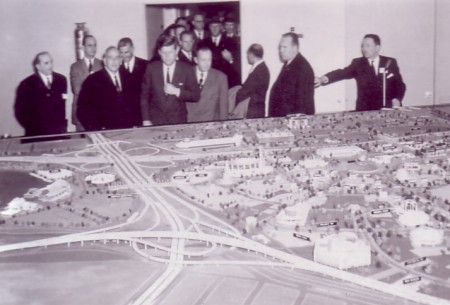 |
|
|
THE CEREMONY
At the site there was a tent and a large bulldozer
and the crowd of about 100. I watched as the President and dignitaries
gathered under the tent. It was bitter cold and windy and you
could hear planes from LaGuardia and the clanging of the No.
7 train in the background. I remember the scene looked majestic,
maybe because I had never seen a ceremony before. The wood podium
had a big Seal of The President of the United States on it. Wow!
Then Mayor Wagner, Norman K. Winston (Commissioner of the US
Pavilion) and Mr. Moses spoke. I could not believe that this
was the same man who was kind enough to take the time to send
me all that Fair stuff and now, here he is! With the PRESIDENT
OF THE UNITED STATES! In my backyard!
"We are delighted, Mr. President, that you
have come personally to inaugurate the central exhibit of the
World's Fair," Moses said. "And thus again to demonstrate
dramatically your wholehearted support of this Olympics of
Progress and to help us celebrate the 300th anniversary of
a great city which has so long been a haven of hope and a bastion
of freedom to the adventurous and oppressed of every land."
"We are in the midst of giant preparations
which, to a trained eye, represent much more than volcanic disturbance
of the landscape and rude interference with travel. Grover Whalen
found long ago that it takes a certain amount of chaos to make
a Fair. Shills as well as shovels are needed, and I speak for
the shovelers."
Moses continued, "The breaking of ground for this pavilion
is no childish prank. It marks the rising crescendo of construction
and the beginning of order and harmony." He concluded by
saying, "We want you to come again in 1964 to open this
exposition, further emphasizing your leadership in world affairs
and your confidence in peaceful assembly and healthy rivalry
among the nations."
Then Moses gave Kennedy the first gold medal of
the World's Fair and Kennedy took off his overcoat (which seemed
risky due to the very cold and windy temperature) and spoke:
"I want to express my great appreciation to
all of you who have been connected with this Fair. Mr. Moses,
who has been working so hard to make it a reality; Mr. Winston,
who has been working on the American exhibit; the Mayor who has
given it his close sponsorship since it began, and all of you,
particularly those of you who are building it."
President Kennedy addressing the crowd at the
Groundbreaking Ceremony for the US Pavilion, December 14, 1962
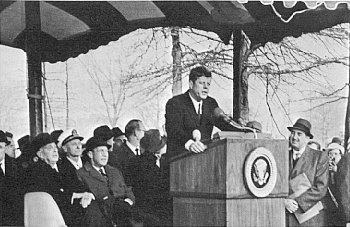 |
"This is going to be a chance for us in 1964
to show 70 million visitors - not only our countrymen here in
the United States, but people from all over the world -- what
kind of a people we are. What kind of a country we have. What
our people are like and what we have done with our people. And
what has been done in the past and what is coming in the future."
"This is what a World's Fair should be about
and the theme of this World's Fair - Peace Through Understanding
- is most appropriate in these years of the 60's." Kennedy
continued, "I want the people of the world to visit this
fair and all of the various exhibits of our American industrial
companies and the foreign companies, who are most welcome, and
come to the American exhibit - the exhibit of the United States
- and see what we have accomplished through a system of freedom."
"So we begin today," JFK concluded, "with
this ceremony. We'll begin again in April of 1964. And we'll
show what we have done in the past and even more important -
what America is going to be in the future. Thank you."
With that the President jumped away from the tent
and went straight to a group of construction workers who surrounded
the large bulldozer that was nearby ready to begin the real excavation
work after the hoopla and big shots left. Apparently, to the
consternation of Fair planners who had the customary golden shovels
ready for the dignitaries to break ground for the official photo-op,
Kennedy instead went over to the earthmover where a driver was
seated, reached up and shook the man's hand. The startled but
delighted driver said "You want to try it?" Kennedy
then immediately climbed up on the seat as the driver moved aside.
With the aid of instructions, the President stirred up the ground
for a short distance. The photographers loved it and Kennedy
then got off the truck, walked and shook hands with the crowd
(there were no barricades) and flashed the most winning smile
I've ever seen.
When you hear stories today about that Kennedy
magic, I can honestly say it was true. It was not just the
fact that he was the President, but that clipped, cadenced voice
in that crisp, cold air at Flushing Meadows that day struck me
like nothing I had ever seen. Suddenly the Fair, which I had
become enchanted with as an idea, took on a newer meaning. I
didn't quite know what it was. The adults called it Kennedy's
"New Frontier," but it seemed Kennedy and the Fair
were on a launching pad to something very bright and good.
Mayor Wagner's remarks to the President echoed
in my ears: "We are proud indeed to have with us on this
occasion the great President of the United States. He honors
us and honors this Fair by joining with us on this occasion.
We salute him today, as the World's Fair will salute him in 1964
. . .We hope you will bring us luck -- the luck of the Kennedys
and of the United States of America."
I got to shake Kennedy's hand. Then he waved and
was gone. I think the whole thing didn't in total take more than
about 45 minutes. But those minutes changed something in me.
I walked back home and trying the next week to describe the event
to my classmates, like my teacher requested, seemed to escape
me. My backyard, my world, had changed.
|
|
COUNTDOWN
-
-
THE WHITE HOUSE
- Washington, D.C.
- Dear Mr. Moses:
- I have written the Mayor assuring him of my support of
the World's Fair, which under your direction and leadership will
be, I am sure most successful. You can be sure of my continued
interest and the support of the Administration. I hope to be
with you at the ribbon cutting.
- Sincerely,
- JOHN F. KENNEDY
-
|
The Fair had been born in the last days of the
Eisenhower Administration but it was the renewed vision and vigor
of the Kennedy Administration that injected the enterprise with
the spirit of The Space Age, the optimism and purpose
of a new world being born. Kennedy sensed the importance of the
Fair in promoting his New Frontier agenda and personally approved
the theme for the US Pavilion to be "Challenge to Greatness."
Thomas Deegan, Fair Executive Committee Chairman
and Robert Moses, Fair President, confer with President Kennedy
in the Oval Office. On the table is a presentation model of the
Unisphere, presented to Kennedy as a gift from the Fair.
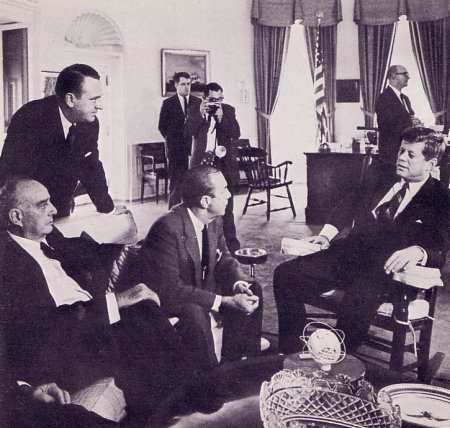 |
When Moses wanted a hearing at the White House
over some problem with the Federal bureaucracy over the State
Department's blockage of a Soviet Pavilion at the Fair (they
didn't want it) or Congress' reluctance for a big appropriation
for the Federal Pavilion, he got it from Kennedy. The President
kept the miniature Unisphere that Moses had given him on a shelf
in the Oval Office .It was an odd alliance I always thought,
between this old lion and this young prince. But I would discover
only much later what drew these two seemingly opposite types
close together.
On April 22, 1963, one year before the opening
day of the Fair, Moses held a meeting of the Board of Directors
in the Administration Building, He had arranged to acquire an
impressive looking "Countdown Clock" that had been
used by the Seattle World's Fair in 1962. The Century 21 Exposition,
as it was officially called, had used the machine to count down
the months, days, minutes and seconds to opening day for that
Fair. President Dwight Eisenhower had personally pressed the
button in the center of the machine to activate it. Moses loved
the clock and thought it would be a great incentive for all Fair
workers to see it as they entered and left the Administration
Building. So it was placed prominently in the entrance lobby.
At that Board of Directors meeting, he arranged for it to be
activated from the Oval Office by none other than the President
of the United States using the first "touch-tone" push-button
telephone.
The President's remarks were piped-in directly to the meeting.
"Mr. Moses, Members of the Board, guests and builders of
the World's Fair; In December I attended your Groundbreaking
Ceremonies and, 366 days from today, I plan to attend your opening.
We have a deadline to meet and by dialing "1-9-6-4"
I launch the final phase of this great effort." With that,
JFK pressed the four tones and, in true space-age fashion, the
countdown clock began.
The "Countdown Clock" in the Fair's
Administration Building. Note both the New York and Seattle World's
Fair logos appear on the front of the Clock. The clock was acquired
from the 1962 Seattle World's Fair. The large button in the middle
was used to start the clock for the Seattle Fair by President
Eisenhower. President Kennedy started the clock for the 1964 Fair's
countdown by touch-tone phone.
 |
|
(Copyright 2003
David G. Oats and nywf64.com)
|
NOVEMBER 22, 1963 - APRIL 22, 1964
It was those memories that drew me back to that
Administration Building, that Park, on that fateful day in November,
1963. It was hard to look at that same place where I had seen
President Kennedy, so alive, young and full of life and the future.
I was not alone. Oscar Hengsltler, the old Scandinavian man who
was the building's maintenance director, was lowering the three
flagpoles to half-staff. The US, NY City and World's Fair flags
went halfway down and I saw this proud man crying as he did it.
I left him alone.
Inside the Administration Building, the bustle
was gone. Secretaries, guards, Fair executives, press people,
everyone, seemed dazed. More than a dozen people I heard say
"I just saw him...he was right here" about the day,
almost a year before, when JFK walked those halls. I just observed.
But I came to that place for the very same reason. It was a way
to try to touch something lost. I went to the darkened and quiet
model room and looked at that Heliport model that seemed to so
fascinate a President. The toy had lost a little magic for me
but at the same time it seemed oddly more special because the
President who was gone - had been there.
Then I spotted Marion Ritz, Moses' longtime personal
secretary, who was telling the staff that Moses was "closing
the Fair (meaning the offices) and everyone should go home."
This surprised the staffers who knew Moses did not want to waste
a minute's worth of work to meet the Fair's deadline. I then
saw Ann Petaine, Moses' phone secretary, tearfully getting into
her husband's car. She said, "You know I never saw the boss
cry before." and then she said "Mr.Moses said it was
just a cold he had. Just go home and be with your family."
I think she was as unnerved at Moses' emotion as she was over
her own.
The Administration Building was soon empty and dark with only
a Pinkerton Guard at the lobby entrance. I found it hard to leave
that place, but the guard said "you better go home now kid."
As I left I noticed the only sound was the beeping seconds of
that countdown clock. While the world seemed to stand still,
it was still counting away the days, hours, minutes and seconds
to an April day -exactly five months away- when the great Fair
would open. But without the man who had started that clock.
Now I knew where to go. I walked back home.
"Don't let it be forgot that once there was a spot
for one brief, shining moment that was known as Camelot."

|
|